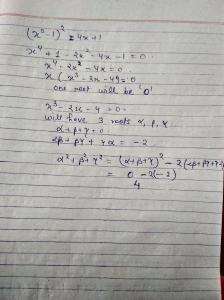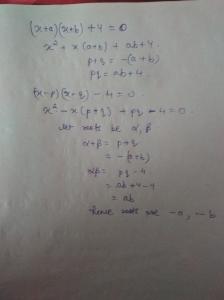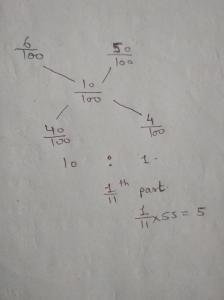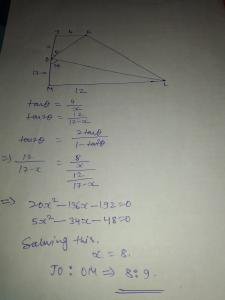Find the sum of squares of roots of the equation (x2 - 1)2 = 4x + 1.
0
-2
-4
4
![]()
Two real roots of a quadratic polynomial (x + a)(x + b) + 4 are p and q. What are the roots of the quadratic polynomial (x - p)(x - q) – 4?
a, b
–a, -b
a-2, b-2
–a-2, -b-2
![]()
Find x such that |x + a| - |x - b| > 0 where a < b.
x > b
x < (b - a)/2
x > (b - a)/2
None of these
![]()
Que.26
Find the values of k for which x2 – 2kx + 2k – 1 is always positive for any real number x.
k > 0
k > 1
![]()
all real numbers
x2 -2kx + 2k -1 > 0.
Coefficient of x2 is positive.
Discriminant should be less than 0.
(-2k)2 – 4 . 1 . ( 2k -1) < 0
4k2 -8k + 4 < 0
( k-1)2 < 0.
which will never be negative Hence, no solution .
From a deck of 52 cards, a card is picked and its value is recorded (say 10 of spades) and it is placed back in the deck. This process is repeated 100 times. Let there are x different possible outcomes, then find the remainder of x with 5.
1
![]()
2
3
A motocycle has brand new tyres on both wheels. A Tyre is considered worn if its has run 15000 km on the rear wheel or 25000 km on the front wheel. What is the maximum possible number of kilometers that the motorcycle can run until the tyres become if the front and rear tyres are interchanged at the appropriate time?
ans: 18750
front can do work in =25000
rear can do work in=15000
together they will do max work in= x
1/x=(1/250000)+(1/15000)
x=75000/8=9375
this is the time or the km after which we can change them so they have travelled 9375 and when they are changed they can travel 9375 more
so total distance travelled =2*9375=18750 (answer)
The number of positive integral solutions to the equation 4x + 5y + 2z = 111
4x+2y = 111-5z
Put z=1
2x+y=53
Possible values for y=1,3,...51
26 Solutions.
Now z=2. This case won't be possible.
Next, take z=3
2x+y=48
y=2,4,....,46
= 23 solution
It will make a series of: 26+23+21+18+16+13+11+8+6+3+1=146
How many real solutions does the equation given below have?
(2x2 – 5)x^2 – 3x = 1
L.H.S will only be equal to 1 when either base is 1 or power is 0
Base =1
2x^2= 6
x= +√3,-√3 .{2 values}
Power =0
x^2-3x=0
x(x-3x)=0
x=0,3 {2 values }
One more case will be there when base is -1 and power is even but we have to check it
Base=-1
2x^2= 4
x=+√2,-√2
Putting in power we don't get a rational no. Hence this will not be the case
Total values = 4
If x,y and z are positive real numbers such that none of them is equal to 1. Further logxyz + logyz =5 and logzxy + logyx = 3. Find all possible real numbers a such that yz = xa
1,3/2
3,3/2
![]()
4,4/3
2,9/2
An ice cream is made by mixing Elaichi and Pista flavoured creams. The 55-gallon container is mistakenly filled in such a way that it has 6% Eliachi flavoured cream. How many gallons must be removed and then replaced with a mixture containing 50% Eliachi cream so that the resulting mixture has 10% Eliachi cream?
2.5
5
![]()
In 55 gallon we have 6% = 3.3 gallon elaichi
Now let x gallon is taken out then elaichi taken out will be 6x/100 and replaced with same quantity which contains (1/2)x elaichi and then it becomes 10 %
{3.3- (6x/100) +x/2 }55 = 10/100
Solving this we get x= 5 gallon
In trapezoid JKLM, JK is parallel to LM, angel J is a right angle and JK=4, JM=17,LM=12, and O lies on JM such that angle JOK=1/2 of angle LOM. Find the ratio JO: OM.
8:9
![]()
Vinayak bought a ticket for the grand finale of the ‘Bull fighting’ challenge in Valencia, Spain. Unfortunately, he had to change his plans and decided to sell his ticket. He expected a lot of demand for the ticket but had to sell it for 1/2 of what he had initially quoted. This reduced his profits by 60%. His profit margin, in %, must have been
25
75
66.66
In triangle ABC, right angled at B with integral lengths, secA – tanA = ½ where A is the angle opposite to side BC. Which of the following can be the inradius of this triangle?
1/2
3/4
1/4
1
![]()
secA - tanA = 1/2
h/b - p/b = 1/2
(h - p )/b = 1/2 ... (1)
We know , r = ( p + b - h)/2 ... (2) [ in a right angled triangle. ]
from (1) and (2)
r = b/4.
smallest possible value of b is 4 ( as it forms a pythagorean triplet )
Hence r = 1.
SecA - tanA = 1/2 .......(1)
Since sec^2 (A) -tan^2 A= 1
Sec A - tan A = 2 .........(2)
Adding 1 And 2
2sec A = 5/2
Cos A = 4/5
Triangle is integral with sides in ratio 3,4,5
Inradius = (AB+BC-AC)/2
putting value we get 1
Alternatively :
If all sides of a right angled triangle are natural numbers then inradius is always a natural number .
r = ( sum of legs - hypotenuse )/2
Hence option (D).
The coefficient of x6 in the expansion of (x2-6x+3).(1+x)7 is:
49
70
-63
-70
![]()

0.01
1
10
100
![]()




